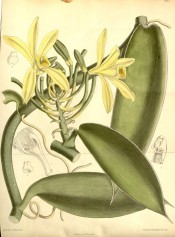Vanilla planifolia Andr.
Frost-tender, climbing, vine-like orchid, reaching a large size, with fleshy stems and leaves and aerial roots arising from each stem node, with short, axillary racemes of up to 20, fragrant, whitish-green to yellow flowers in summer. Vanilla pods are harvested from several Vanilla species, the most important being planifolia. They are grown on support shrubs and trees throughout the tropics. The name aromatica suggests one of these species, most probably planifolia. [RHSD, Hortus].
Horticultural & Botanical History
‘[Vanilla] was found to be used by the natives of Mexico as a condiment to chocolate on the occupation of that country by the Spaniards, who introduced it into Europe. The first botanical notice of it is by Clusius, in his “Exoticorum Iibri,” lib. iii. c. 18, 72 (1605), who received a specimen of it from Morgan, apothecary to Queen Elizabeth, in 1602, and who described it as “Lobus oblongus aromaticus,” without being aware of its native country or uses. It was, however, known much earlier to Hernandez, for the figure in his Thesaurus, which appeared in 1651, was one of a series of 1200 executed at great cost in Mexico, by order of the King of Spain, during the previous century. In 1703 Plumier first gives it the name of Vanilla, that being the name in use in Mexico by the Spaniards; and he enumerates three species, distinguishing planifolia by its white or green flower and black fruit. At the end of the seventeenth century it was imported into France through Spain, and used for flavouring chocolate and scenting tobacco. In 1721 it had a place in the London Pharmacopaeia, but gradually disappeared from the druggists’ shops, finding a refuge with increasing favour with the confectioners. For many years the principal imports were from Mexico, but latterly the French, Dutch, and English colonies. especially Bourbon, Java, the Mauritius, and Honduras, chiefly meet European demand’ [BM t.7167/1891]. BM t.272/1794.
‘This elegant plant is a native of the West Indies, where it is found climbing to the tops of high trees, to the bark of which it attaches by its roots, in the manner of ivy. [It] thrives very well in the stove. […] We have it growing luxuriantly to the height of twenty feet.’ [LBC no.733/1823]. Andrews’ Botanical Repository states that it was introduced by the Marquis of Blandford. [ABR pl. 538/c.1807].
History at Camden Park
Probably introduced to the gardens between 1845 and 1850. Listed in the 1850 and 1857 catalogues [O.51/1850]. It may have been sent as seed from Tahiti by Bidwill and raised by Macarthur. A single plant was presented to the Sydney Botanic Gardens by William Macarthur on 27th September 1847 [RBGS AB].
Notes
Vanilla aromatica Sw. = Epidendrum aromaticum (Sw.) Parmentier, a Guatemalan species, introduced to Britain in 1835. [RHSD]. This could be Macarthur’s plant.
Published Jan 26, 2010 - 05:02 PM | Last updated Jul 29, 2010 - 01:28 PM
| Family | Orchidaceae |
|---|---|
| Category | |
| Region of origin | Mexico |
| Synonyms |
|
| Common Name | Vanilla bean vine |
| Name in the Camden Park Record |
Vanilla aromatica |
| Confidence level | medium |
